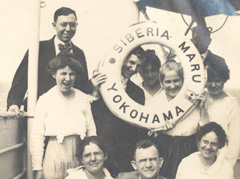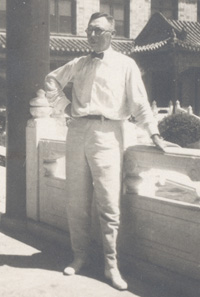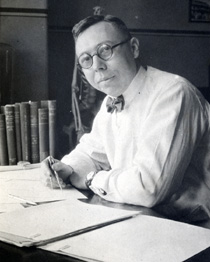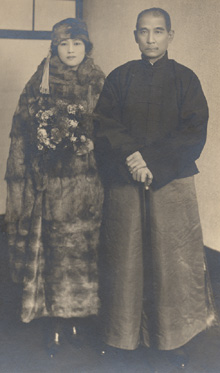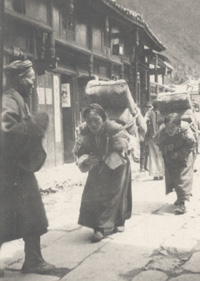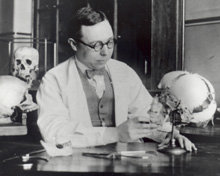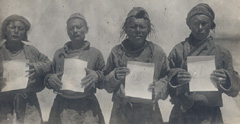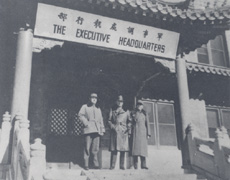Bodies and Bones: Washington University Medical Alumnus Paul Stevenson at Peking Union Medical College
By the early twentieth century, Americans by the thousands traveled each year to China, a land still perceived to be the heart of the exotic Orient and about which most in this country knew relatively little. Passenger steamship lines plied the Pacific on regular routes, and although it could take weeks to reach a destination – depending on the ship’s course and the ports of call and whether or not transfers to other conveyances were necessary – sea voyages were no longer daunting as in the earlier age of sailing vessels. Although the vast majority of travelers went on business or as tourists, some journeyed to China for other reasons, including saving souls, making scientific discoveries, and improving cultural understanding. Paul Huston Stevenson of St. Louis heard more than one call to China. He in fact combined religious zeal with scientific and cultural curiosity to a degree few others of his time could match. [1]
When the China Medical Board of the Rockefeller Foundation began recruiting faculty members to teach at the Peking Union Medical College – an almost quixotic initiative to bring Western medical science to the Orient – standard policy was to contact American universities which were beneficiaries of Rockefeller support. Among the personal contacts was Robert J. Terry, head of the anatomy department at Washington University, whose full-time teaching position had been endowed by the petroleum dynasty’s philanthropic arm. Terry recommended Stevenson. The younger man must have seemed an ideal choice, given a Rockefeller commitment “to maintain the religious tone and work in the [Chinese] college and hospitals” – part of an agreement with the London Missionary Society, which had sold its Union Medical College in Beijing [2] to the CMB. Not only was Stevenson a recent graduate of a newly reorganized and prestigious Washington University School of Medicine, he was also an ordained clergyman with the Disciples of Christ.
Stevenson was born in 1890 in Monmouth, Illinois, the son of a clergyman. While he was in his teens his family moved to St. Louis, where he graduated from Central High School in 1909. Stevenson entered Hiram College, which was affiliated with the Disciples of Christ. There he studied for bachelor’s degrees both in science and divinity, completing them in 1913. At Washington University, Stevenson distinguished himself very early in anatomy, winning the George F. Gill Prize, an award to the student with the highest marks in the subject at the close of the first year. While a medical student Stevenson met June Lapsley, who was training to be a nurse at St. Luke’s Hospital in St. Louis. After a short courtship, the two were married in 1914. The young couple’s financial problems were addressed when a suburban Disciples of Christ congregation, the Maplewood Christian Church, advertised for a new pastor. Paul and June Stevenson arranged to lead the congregation jointly until he completed his work at Washington University. In 1916 June gave birth to twins, Robert and Margaret. Despite mounting extra-curricular responsibilities, Stevenson graduated high in his medical class and was tapped for membership in the honorary fraternity Alpha Omega Alpha.
There was one substantial obstacle to Stevenson’s recruitment by the China Medical Board, namely, PUMC was not ready for him in 1917. The anatomy building in Beijing was then only in the planning stage. This problem was overcome, thanks again to the Disciples of Christ. The denomination maintained medical missions in several Chinese cities, notably in the Yangtze River valley. Its foreign missions organization agreed to co-sponsor the Stevensons and to employ Paul in one of their hospitals until his PUMC position could function. Accordingly, in the summer of 1917, the Stevensons and their two infant children departed for Shanghai. Their first lengthy stay, lasting about a year’s time, was in Nanjing, at the oldest Disciples mission in China. Here the Stevensons began intensive study of the Chinese language.
From the moment of their arrival, contrasts in terms of politics, topography, climate, and the standard of living of the people in the various parts of China must have been very striking to the Stevensons. The port cities of Shanghai, with its multinational foreign concessions, and Hong Kong, which was governed by the British as a Crown Colony, were participants already in what we now call a “global economy,” and were quite attuned to major international developments in science and technology. Other towns the Stevensons visited were not as developed technologically, but at least were in regions where local authorities exercised a measure of control – Westerners often deemed such provincial leaders “warlords” because they governed autonomously of the national government. Certain other regions, by contrast, were contested by renegade forces regarded by Westerners as “bandits,” and who on occasion attacked and robbed convoys and railroad trains traversing their sphere of influence. Nationally, China was undergoing a protracted power struggle between rival “generalissimos,” who held strategic cities, such as Duan Qirui (Tuan Ch’i-jui), in command of Beijing, and Sun Yat-sen, who controlled Guangzhou (Canton) and much of the south. This state of anarchy and civil war had been exacerbated with the fall of the last “legitimate” imperial dynasty, the Qing (Ch’ing), less than a decade earlier.
The following summer, 1918, the Stevensons moved a hundred miles west of Nanjing, to Hefei, capital of Anhui Province, where forces allied with Duan were in power. Hefei, situated in one of China’s most productive rice and wheat growing regions, was the site of a small mission hospital. The institution had been built late in the previous century, when the city was known as Luchowfu, and still bore the old name, Luchowfu Christian Hospital. Pioneer missionaries in the region had suffered through two outbreaks of violence directed at foreigners in 1891 and 1900. But by 1918 Anhui was contested by warlords who fought only among themselves, leaving missionaries for the most part in peace.
Stevenson was named superintendent of the hospital. In this capacity the young physician struggled against a gamut of medical problems in addition to being charged with upgrading the training of the native staff. Cases of meningitis reached epidemic proportions in Anhui. There was unquestionable need for a physician with Stevenson’s background and skills in Hefei. Yet the situation and its responsibilities did not deter him from his original objective of pursuing a career in anatomical research. In 1919, Stevenson wrote to E. V. Cowdry, who would be his department chief in Beijing, “I feel more or less orphaned here in my present work . . . and [I am] biding my time for the day when I can return for further study in one of the allied subjects of anatomy, probably embryology.”
Cowdry was a Canadian who had established his career in the United States with advanced studies at the University of Chicago and Johns Hopkins University. [3] He was delighted at the prospect of adding an embryologist to his department. In 1920, the laboratories and other facilities finally ready for operation, Stevenson received his appointment as assistant in anatomy. He and his family moved to Beijing in September. They were provided with a house in the PUMC compound, completely furnished and staffed by five servants. Stevenson was afforded his own laboratory. During the summer of 1920, Cowdry himself was away on leave in the United States. In his absence, the Anatomy Department was headed by Davidson Black, who had come to PUMC in 1919.
Stevenson was immensely pleased with his new position. From the isolated primitive conditions of Hefei, PUMC was like stepping forward a century or more in time. (In an essay published about this time, the American-trained Chinese educator and journalist Hu Shi referred to PUMC as “an airplane college in a wheelbarrow country.”) Stevenson was assigned to teach gross anatomy. His elite students entered the laboratory from their premedical studies scientifically prepared and able to receive instruction in English. But Stevenson’s ability to speak and write Chinese, surpassing the level of his Western colleagues, was a great asset, for it permitted him to develop personal rapport with students. Already when he was still in Hefei, a perceptive Mandarin transliterated his surname as Xu Wensheng, which not only approximated the pronunciation of Stevenson but also could be translated roughly as “Xu (a common surname), the born scholar.” The Chinese appreciated his willingness and ability to learn about their culture. Stevenson became, it was later remarked, a kind of unofficial “dean of students” at PUMC.
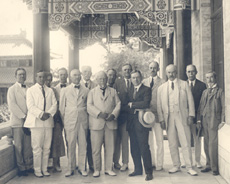 |
| John D. Rockefeller, Jr. and others gathered for the dedication ceremonies of Peking Union Medical College, 1921 |
By 1921 major construction throughout the PUMC campus was complete and in September the official dedication took place. It was a festive occasion. Distinguished scientists from around the world attended. Present to deliver the principal address at the ceremonies was the great benefactor himself, John D. Rockefeller, Jr. The General Bulletin of the Rockefeller Foundation borrows an almost romantic tone in its description of “scientists from the East and from the West [marching] together in occidental academic costume, passing in slow procession beneath the great overhanging roofs of green tile, past modern laboratories and age-old water carts, through rows of students of Western medicine and past groups of wondering coolies and ever-present beggars.”
Davidson Black had by this time been named to succeed Cowdry as head of the Department of Anatomy. Like Cowdry, Black was a Canadian – they had been undergraduates together at the University of Toronto – with U.S. graduate training. Black’s specialty was paleontology, having received a doctorate in the field from Western Reserve University in Cleveland. His promotion was approved with misgivings expressed by some members of the China Medical Board, who would have preferred a chief anatomist with a specialty more oriented to clinical medicine.
But Black was not alone in Beijing in his choice of research interests. China at this time afforded extraordinary opportunities for work in paleontology and anthropology. It had long been surmised that the arid interior of the Middle Kingdom and Mongolia would yield fascinating discoveries concerning the evolution of the human race. The suppositions were based in part on observations by geologists and mining engineers employed by the Chinese government to find iron and coal deposits. Commenting on fossil-bearing deposits found in a hillside at Zhoukoudian, not far from Beijing, a Swedish mining engineer, J. Gunnar Andersson, went so far as to pronounce: “here is primitive man, now all we have to do is find him!” By the 1920s, the international scientific community was ready and able to explore these leads. Several well equipped expeditions were mounted, among the best publicized and financed being one led by Roy Chapman Andrews of the American Museum of Natural History in New York. Launched in 1921, his venture aroused intense interest among the American public, particularly after it was represented in the popular press as the hunt for the “missing link.”
Stevenson and Black joined the Andrews expedition for a short period after it established a base in Mongolia early in 1922. The venture deeply impressed the young St. Louis doctor. He decided to put aside his work in embryology in favor of investigations in physical anthropology. Stevenson realized, however, he lacked sufficient background to pursue this new interest. Already he had a leave of absence approved for 1922-1923 and now, with Black’s recommendation, he applied to study at Western Reserve University. With his wife and children, Stevenson journeyed the long distance to Cleveland. There he undertook a postgraduate course in human osteology. Western Reserve, along with Washington University in St. Louis, was home to one of the premier collections of human skeletons in the United States. Anatomical research at the time was still dominated by scientists who depended on the naked eye, looking for clues to human development in general and racial characteristics in particular with their specimens literally in hand. For its part, the China Medical Board fully supported such research and was generous in granting leave permitting its scientists to sail across the globe on scientific missions. This largesse extended to affording the families of families to visit home – and ironically sometimes profiting from the opportunity to get stateside medical attention.
Upon returning to PUMC, Stevenson elected to specialize in anthropometry, focusing on the diversity of living populations, rather than to join Black in paleontology. All the same, his studies were forcing him to come to intellectual terms with theories of human evolution he had once rejected on religious grounds. How did the human race become so varied? His denomination, like many of the time, ascribed to a very literal interpretation of the Biblical creation story wherein our ancestors were a historical couple named Adam and Eve. While never openly renouncing ties to the Disciples of Christ, he plainly came to distance himself from the teachings of his church. This was somewhat painful for him. In one of his writings he confessed “. . . Oriental students are fortunate in not having had canonized for them by zealous forefathers those particular ancient writings that recorded the early ideas of the race on the subjects of human origins and cosmic relationships. The fundamental viewpoint of man’s place in nature has never had and never will have to suffer the radical change in the Eastern mind that has been necessary in Western Christian thinking.”
With regard to such intellectual confrontations, Stevenson found a soul mate in Beijing in the person of the French Jesuit and paleontologist, Pierre Teilhard de Chardin. Teilhard first visited China in 1923, the year when he had been dismissed from a theological faculty in Paris for publishing books and essays contrary to the official teachings of the Roman Catholic Church. Central to Teilhard’s condemned views was his belief that evolution and Catholic doctrine could be reconciled. He and Stevenson became fast friends. Teilhard was permitted to work at the PUMC Anatomy Building and frequently joined Black and Stevenson on forays outside the city to the beginnings of excavations at Zhoukoudian. Official sanction by the Society of Jesus to work with fossils only served to deepen and expand Teilhard’s view that he was studying evidence of divine plan. [4]
The power vacuum placing much of China in the hands of warlords and bandit chieftains continued into the mid 1920s. But political forces were slowly being organized to unify the nation. Most powerful was the Guomindang, the National People’s Party, which underwent reorganization under the leadership of Sun Yat-sen in 1924. The fledgling Chinese Communist Party was active at this time as well, but members were under orders by the Communist International to infiltrate the Guomindang rather than to control for power on their own. Sun accepted Russian advisors sent by Stalin to assist in the reorganization of his forces. From the point of view of some observers in the foreign community, the growing power of the Guomindang was a radical threat to their privileged existence. Sun, however, was a known entity to Western governments; having struggled for power for a quarter century and having converted along the way to Christianity was considered personally respectable. He and his forces reached an accommodation with Duan, who as the political boss of Beijing remained as Provisional Chief Executive of China.
Early in 1925, Sun came to Beijing to confer with Duan and others about the future of the country. While he was in the capital he became seriously ill and was admitted as a patient to the most advanced treatment center in the city, PUMC Hospital. He was diagnosed as suffering from advanced abdominal carcinomatosis. By March he was dead. The disposition of Sun’s body now posed a delicate political problem for the college. Nationalists of every faction revered the deceased as a hero and there were immediate plans by the party leadership for building a gigantic mausoleum in his honor, where the embalmed body could be seen by his people, more or less like the remains of Lenin, who had died the previous year in Moscow. The embalming was assigned to Stevenson. He was required to respect rigorously the traditional Chinese taboos against removing internal organs from the body. The work was performed in a temple located between Beijing and Zhoukoudian. Stevenson had custody of the body for two years – he kept it from visible decay by immersion in mineral oil, which he regularly changed (his own pun intended) – a period during which the political struggle determined where the final resting place would be. Ultimately, following a decree of the new supreme leader, Chiang Kai-shek, Sun’s tomb was constructed at Nanjing. All parties agreed Stevenson fulfilled his assignment flawlessly – although subsequent mishandling by others in Nanjing prevented placing the body on display – and he was later to be awarded the “Order of the Blue Jade” by the Nationalist government for his work.
PUMC faculty generally believed travel outside Beijing to be safe if proper precautions were followed. It was a shock therefore to learn late in 1925 that one of their number was captured by bandits. Harvey J. Howard, professor of ophthalmology, was visiting an American friend at the latter’s ranch in northern Manchuria, located not far from the Soviet frontier. After ten grueling weeks of pursuit by the regional warlord, who was allied with the national government, the band of abductors was overtaken and Howard was freed. [5] It is unlikely the Howard incident deterred the anatomists at PUMC from planning research expeditions, but it was certainly a warning to take more stringent measures to protect themselves.
In 1926, the spring of the year following the ophthalmologist’s release, Stevenson set forth on a long journey through the mountainous borderland between Sichuan province and Tibet. His objective was an “an anthropological reconnaissance” of the many distinct tribes and peoples of the region. He succeeded in encountering and defining characteristics of hundreds of ethnic groups, recognizing similarities in some to American Indians. Along the way, Stevenson was nearly lost by his party on a mountain pass and later almost drowned in the fierce current of a river. Chinese political anarchy gave him little trouble, except in Sichuan, where feuding military factions blocked travel on the main highway to Tibet, forcing lengthy detours.
With the publication of his findings from the Tibetan borderland and the elaboration of his anthropometric technique, Stevenson won an international reputation as an expert on ethnic minorities in China. He was promoted to assistant professor at PUMC. Late in 1926, he was asked to be consultant on plans for an elaborate German-financed expedition across the Gobi Desert to the far westernmost region of China, Xinjiang. The expedition was led by the Swedish geographer, Sven Hedin. At this time Hedin was probably the most famous living European explorer. He had begun his travels in the 1880s and had counted among his patrons Kaiser Wilhelm II of Germany and Tsar Nicholas II of Russia. He was the author of 24 books, each translated into many languages. For Hedin to call upon Stevenson for assistance was a distinct honor for the American and he gladly instructed Hedin’s medical staff in the fine points of anthropometry.
Stevenson was not personally to join the “Sino-Swedish Expedition,” as it was commonly known. He had a leave of absence planned and had arranged to travel to England. Moreover, political tensions in China had increased, so by the winter of 1926-1927, only the most daring foreigners were planning forays to other parts of the nation. Chiang Kai-shek, Sun’s successor as head of the Guomindang, had undertaken a campaign north from his stronghold in Guangzhou (Canton) and was attempting to take control of cities in the Yangtze Valley. Insurrections fomented by Communists in Nanjing and Shanghai resulted in the killing of a small number of foreign residents, enough to trigger a wave of fear among the enclaves throughout the country. Many of the PUMC faculty, Stevenson included, evacuated their dependents from Beijing to the relative safety of the seaport Dalian. June Stevenson and the children waited there until Stevenson’s commitments in the capitol were finished for the year.
The Stevensons then went to London, where he studied under Karl Pearson, who was professor of eugenics at the University of London. Pearson was an acknowledged leader in the field of biostatistics. He had developed hundreds of mathematical formulas applicable to areas of interest to Stevenson, ranging from models for testing theories of evolution to means of computing skin surface from height and body weight. From hindsight we know such methods were a program of the eugenics movement and thus linked to proposals for “improving” humanity by means such as compulsory sterilization of “degenerate stock.” Pearson further believed his science was the basis for judging the superiority of certain racial and ethnic types over others. Stevenson, as far as written or anecdotal evidence indicates, never gravitated to such extreme views. But he did share a view of humanity defined by ethnic differences, rather than – as confirmed by genomic analysis – the surpassing unity of our species.
On Stevenson’s return to Beijing he was promoted to associate professor at PUMC. He found his colleagues at the Anatomy Department absorbed in work relating to human evolution, not at Pearson’s theoretical and politically charged remove, but with all eyes trained to the fossiliferous deposits of Zhoukoudian. Stevenson had already witnessed some of the excitement. As early as 1923, a hominid molar was discovered in a cave on the site by members of a Swedish team. Finds of other fossilized teeth followed. The investigations were now officially in the hands of the National Geological Survey of China, headed by Pei Wenzhong and Young Zhongjian. The National Geological Survey accepted Black as “honorary director” and Teilhard as “honorary advisor.” The name “Peking Man” was first applied colloquially to the prehistoric inhabitants of Zhoukoudian. In 1927, however, Black officially designated a generic status, as Sinanthropus pekinensis.
In 1929, by agreement between PUMC and the National Geological Survey, facilities in the Anatomy Building and adjacent Lockhart Hall were officially declared the “Cenozoic Research Laboratory,” with special operating costs underwritten by the Rockefeller Foundation. Stevenson was an active participant in the work there. He also contributed to the search for fossils at Zhoukoudian where laborers were slowly stripping away a hillside.
Late in 1929 Pei made the dramatic find of a nearly complete skull. Carefully wrapping this treasure, he transported it to Cenozoic Research Laboratory. Black set to work immediately to free the fossil from its rock matrix. What emerged was judged to be the cranial remains of an adolescent sinanthropus. It was, in the words of Teilhard, who assisted in the work, “as typical a link between man and the apes as one could wish for.” Activity both at Zhoukoudian and in the laboratory intensified. The fervor behind this effort – again we understand from hindsight – reflected a belief that Asia, rather than Africa, was the continent where genus Homo first evolved. Paleontologists of today, by contrast, estimate Peking Man and the earlier-discovered Java Man of Indonesia were either species or sub-species of Homo erectus, which first appeared about 1.8 million years ago in Africa, then migrated to Asia, and later to Europe.
Stevenson and his family were on leave from PUMC in the summer of 1930, during which he lectured at the University of California. When the Stevensons returned, there were signs China was about to embark upon a new era of national unity and strength under the leadership of Chiang Kai-shek. Chiang not only subdued most of the independent warlords, he also began to win back the concessions operated by European powers on Chinese territory. But events in 1931 proved how vulnerable his Guomindang regime actually was.
The one foreign power which Chiang could not dislodge was Japan, which exercised power in southern Manchuria and Shandong. When his government attempted to restrict importation of Japanese goods, Japan declared its vital interests threatened and struck back. In September 1931 Japanese troops stationed near Shenyang (Mukden) attacked Chinese forces and from there seized control of all Manchuria. The Chinese responded to the “Mukden incident” by imposing a total boycott on Japanese goods. This provoked the Japanese to even more extreme actions, including a savage aerial attack on Shanghai and creation of a puppet state in Manchuria, which they re-christened “Manchukuo.” In the following months several attempts were made to reach an armistice between the two warring nations. Repeatedly, negotiations broke down, followed by a Japanese advance until 1933, by which time the invaders controlled all of northeastern China down to the Great Wall.
The situation, of course, worried everyone at PUMC. Teilhard described the uncertainty to a correspondent, “we are living here in profound tranquility, though we expect every morning to wake up and find ourselves annexed by Manchukuo.” At the Cenozoic Research Laboratory the special concern was to extract as many of the precious remains of Peking Man from Zhoukoudian as possible while there was still access to the site. The National Geological Survey was under pressure from the Chinese government to evacuate the laboratory and its treasures from Beijing. Yet, the period 1931-1933 was the very time when the richest finds were being made. Major sections of the once inhabited cave were opened up, yielding more skulls, jaws, teeth, a clavicle, and other bones. In addition, there were discoveries of various stone and bone implements, necklaces of pierced teeth, and animal bones. The stratum from which the fossils were taken was judged to have been laid down largely as charcoal and ash, suggesting long duration to the abode of sinanthropus.
The precariousness of the political situation, combined with the inherent appeal of the research, brought world-wide attention to PUMC. Although most of the focus continued on the discovery of hominid fossils, Stevenson’s work in anthropometry also became more widely known in the 1930s through the work of a prominent sculptor. Malvina Hoffman was an American who had studied under Rodin and who was acclaimed for her dramatic, muscular works in bronze and stone. She also developed a style and expertise in rendering distinct ethnic and racial types. In 1929 Hoffman was commissioned to create works for a “Hall of Man” at Chicago’s Field Museum (the Museum of Natural History), and for this she traveled extensively in South and East Asia. There was publicity generated at each of her stops. Not surprisingly, in 1931 one of Hoffman’s longest stays was in Beijing at PUMC. Black and Stevenson granted her space to work in their department and allowed her to accompany them on rounds in the PUMC Hospital and on the streets of the capital. Stevenson advised her, as she later described it, in “studying and selecting representative types of Mongolians, Manchurians, and Chinese, who differed as much in appearance and bony structure as if they belonged to separate races.” The results of Hoffman’s extensive journey and consultations in anthropometry, added onto her considerable artistic talent and empathy for “common” people in distant lands, were realized in a gallery of bronzes that long were an attraction of the museum in Chicago. [6]
In March 1934, Davidson Black died suddenly of a heart attack. Stevenson gave the principal address at a memorial service in Black’s honor. He was named interim department head, but was not appointed to succeed his old boss on a permanent basis. The China Medical Board, accustomed now to paleontologists and pleased with their world-wide renown, appointed Franz Weidenreich, known for his discoveries concerning Neanderthal Man, to fill the post. Stevenson continued principally with his investigations in anthropometry.
Late in 1934 the Stevensons departed once again for the United States. The leave of absence this time gave Stevenson the opportunity to confer with Sven Hedin, who was then touring North America, about the results of the Sino-Swedish Expedition. When the family returned to Beijing, the armistice with the Japanese was still holding. At PUMC, the quality of medical education and research programs was being maintained at a high level, despite austerities necessitated by the international Great Depression. Over the years, increasing numbers of well-trained Chinese faculty were taking positions held originally by foreigners. Their ranks were supplemented by Westerners who were not permanent, but visiting professors. Among the visitors in 1935 was G. Canby Robinson, who twenty years earlier had instructed Stevenson in internal medicine at Washington University and who had served as dean from 1917 to 1920. Robinson was immensely impressed with what he saw. He commented in his memoirs, “In 1935 China was in her modern heyday. It was a favorable time to be there. The medical college was a strong, well-directed institution.” [7]
Robinson was correct about PUMC, but deceived about the political situation. With the Japanese poised so short a distance from Beijing, and the Tokyo government adamant about withdrawal from China, it was inevitable hostilities would break out again. In July 1937, the conflict re-ignited. Japanese troops on maneuvers exchanged shots with a Chinese garrison, whereupon the former moved quickly to seize a town just south of Beijing. At the town was a bridge, dubbed by foreigners the “Marco Polo Bridge.” Over it passed the rail line connecting Beijing to the seaport of Tianjin and also the road linking the old capital with Zhoukoudian. The capital and all its environs fell to the Japanese a month later. Chinese authorities announced there would be no more truces with the invaders. World War II was effectively underway in Asia.
At the time of the Marco Polo Bridge incident, Paul and June Stevenson were en route to the United States on another leave of absence from PUMC. Their travel plans called for a visit with their daughter Margaret, who was in Michigan, followed by another lengthy consultation with Hedin, for which they were to voyage eastward to the latter’s home in Sweden. The couple had departed Beijing fully intending to return. Stevenson had signed a five year contract with the China Medical Board less than a year earlier. Not yet completed was the text of a book on the origins of China’s ethnic populations, which was to be the culmination of his nearly two decades of work in anthropometry. Upon arrival in the United States, the CMB advised Stevenson his teaching and research at PUMC were now terminated, for the institution could no longer vouch for his and his family’s safety in a country at war.
The Stevensons arrived in Sweden late in 1937 and stayed as a guest of Hedin until the following spring. Stevenson worked on his book using data brought back from the Sino-Swedish Expedition. By 1938 Europe had its own war clouds gathering and Stevenson might well have received an intimation of the future conflict while he was the guest of the venerable explorer. Since they last met, Hedin had become an outspoken apologist for Hitler. Perhaps his views were grounded more in nostalgia for the lost world of the Kaiser and the Tsar and in loathing for Communism than in a clear appreciation of Nazism and its extreme racist philosophies. But the Swede had gone so far as to publish a book hailing Hitler’s cause – and indeed would persist in this attitude until the end of World War II. For his part, Stevenson chose to reject Nazi perspectives and during the war years contacts between him and Hedin ended. The goals of identifying and understanding “pure” racial and ethnic types among human populations, however, remained central to him for some time to come.
Stevenson was never a man to waste time bemoaning lost opportunities. Otherwise, he might have protested the decision to terminate his work at PUMC. The American faculty members who remained in Beijing were not called home to the United States. Moreover, the China Medical Board even sent additional visiting professors, once it was learned the Japanese were not interfering with the college. This afforded another fleeting Washington University connection to the college: Eugene Opie, another former dean (1912-1915), taught pathology there in 1939 and 1940. He returned home – by this time, his permanent appointment had been with the medical faculty of Cornell University – calling his year “an illuminating experience.” [8]
At the age of 48, Stevenson decided to make a major career change. Still receiving his PUMC salary as his contract called for, he began study for a doctorate in Public Health at Johns Hopkins University. Thus began a phase of his career that, at least in detail, is a story to be told elsewhere. However, there is a dramatic epilogue to the long involvement of this remarkable scientist in China. In 1941, with his doctorate completed, Stevenson accepted a commission as Senior Surgeon with the United States Public Health Service. At the personal request of Chiang Kai-shek, he was ordered to Burma to serve as a member of the American Medical Commission to the Yunnan-Burma Railway. The Commission was to advise concerning the medical and sanitary requirements of an estimated 150,000 Chinese laborers who were to build the railroad.
At first, Stevenson saw in this turn of events a golden opportunity to study again the tribe peoples of western China. On his journey one more time across the Pacific, he took with him the precious manuscript of his book, intending to finish it during the assignment. But en route he changed his mind, realizing more clearly the rigors of the war ahead. Unfortunately, Stevenson decided to entrust the manuscript to a friend in Manila. Less than a month later, the United States was at war with Japan and the Philippines were invaded. Japanese forces seized Manila and ransacked American property. The manuscript was destroyed – or at least never recovered after the war.
In Beijing, within hours of the reported attack on Pearl Harbor, the gates of PUMC were cordoned off. Not even Teilhard – who, with his Vichy French visa, was technically a “friendly alien” to the invaders – was allowed to enter. Three remaining Americans were arrested by the Japanese and were interned until the end of the war. In a lamentable parallel to the fate of Stevenson’s manuscript, the priceless bones of Peking Man also were lost. Anticipating the open hostilities, PUMC staff had secretly packed the fossils for shipment to the United States. The precious cargo was last accounted for in Tianjin. There it had to be abandoned on the docks and was never seen again. [9]
Stevenson survived the war, serving American forces in India after the Japanese invaded Burma. In 1944 he was transferred to duty in the United States and assigned to offer seminars to medical officers of the Armed Services to prepare them for posts in the Pacific Theater. After the conclusion of the war, Stevenson continued to serve in the U.S. Army until 1952. Then he resigned his commission and took a position with the National Institute of Mental Health. His active career lasted until 1960, when he retired and returned to St. Louis. He died in 1971. [10]
The facilities of PUMC also survived the war. An attempt to reestablish the college by the China Medical Board was aborted by the Communist takeover in 1949. The campus was converted to new purposes, and the clinical facilities were defiantly tagged the “Anti-Imperialist Hospital” during the Cultural Revolution. In the 1970s, when Deng Xiaoping took power in Mao Zedong’s place and relations between China and the United States ameliorated, the institution was renamed the Capital Hospital. Presently the institution is once again the center of one of China’s leading medical schools and is known again officially as Peking – the old spelling still used in this context on official documents in English – Union Medical College.
Endnotes
1. Primary source information is drawn mainly from the Paul H. Stevenson and E. V. Cowdry archival collections of the Becker Medical Library in St. Louis. Among published sources, see especially China Medical Board and Peking Union Medical College; a Chronicle of Fruitful Collaboration 1914-1951, by Mary E. Ferguson (1970) and Western Medicine in a Chinese Palace: Peking Union Medical College, 1917-1951; by John Z. Bowers (1972). [Back]
2. Most Chinese names in this essay are given in the presently official Hanyu Pinyin Romanization (minus diacritical marks). Exceptions of course include the spelling “Peking” in the name of the medical college – the capital city otherwise referred to as “Beijing” – and names of certain well-known historical figures, notably Sun Yat-sen (Sun Yixian in Pinyin) and Chiang Kai-shek (Jiang Jieshi in Pinyin), which follow older conventions. [Back]
3. E. V. Cowdry is the subject of another of my essays on Washington University faculty who were immigrants or traveled abroad for significant periods of their careers. See “A Canadian in the Palaces of the Oil Prince.” [Back]
4. See especially Teilhard, by Mary Lukas and Ellen Lukas (1977). [Back]
5. Howard wrote a thrilling account of his adventure which was syndicated in newspapers throughout the United States and eventually was published as a book, Ten Weeks with Chinese Bandits (1927). He left PUMC in 1927 to become head of the Department of Ophthalmology at Washington University. Howard held that position until 1933, after which he entered private practice in St. Louis. [Back]
6. Malvina Hoffman’s memoir, Heads and Tales (1936) and particularly its chapter “China,” p. 218-49, is the principal source, including the direct quotation (p. 220). Hoffman’s perspective on ethnicity and race – not exactly like Sven Hedin’s, but bearing certain analogies – incorporating an inherently condescending Western gaze, has long since passed from favor. The “Hall of Man” has been dismantled and some of its pieces sold. For a derisive neoconservative commentary on the sculptor’s loss of fame, see “Racial Correctness: The Case of Malvina Hoffman,” by Steve Sailer, <http://www.vdare.com/Sailer/hoffman.htm>. [Back]
7. G. Canby Robinson, Adventures in Medical Education (1957), 242-49. [Back]
8. Eugene Opie considered his Washington University experience thirty years earlier pivotal to his understanding of progressive medical education. See his account of his St. Louis years, entitled “Adoption of Standards of the Best Medical Schools of Western Europe by Those of the United States,” Perspectives in Biology and Medicine, Spring 1970, 309-42. [Back]
9. The fate of the hominid fossils has ever since been the subject of intense controversy and conjecture. See, for example, “Archaeology: Peking Man, Still Missing and Missed,” by Sheila Melvin, International Herald Tribune, October 11, 2005 (which provides an international hotline number) and “China Digs into Mystery of Peking Man Fossils,” by Ching-Ching Ni, Los Angeles Times, April 7, 2006. [Back]
10. Paul Stevenson’s later career is discussed in an oral history narrated by Helen W. Stevenson and Lucy Stevenson (respectively, his second wife and sister), in conversation with this author, 1983, <http://beckerexhibits.wustl.edu/oral/interviews/stevenson.html>. [Back]
Related Resources:
- Biography of Paul H. Stevenson
- Images of Paul H. Stevenson
- Oral History Interview with Helen Wells Stevenson and Lucy Stevenson
Back to Articles

